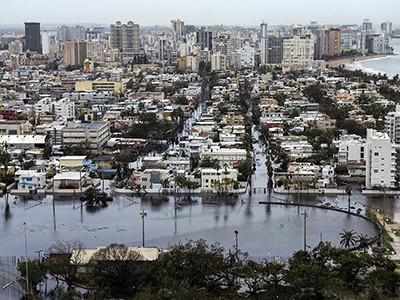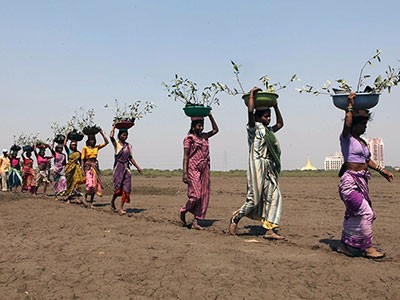My home town of New Delhi is battling with air pollution, contaminated water supplies and heatwaves. Just last November, schools were shut for more than a week because of untenable air quality. In the past 5 years, students have missed at least 26 days of school for this reason. The city is one of an increasing number of places where rapid, unplanned urbanization has undermined the environmental services essential for a good quality of life. The built environment grew globally by two-thirds between 2000 and 2012. Almost half of cities’ economic output depends on natural systems that are threatened by climate change and biodiversity loss. By 2050, 70% of people will live in cities; 3 in 4 of these urbanites will face water scarcity.
To thrive, cities must lean into nature. That means having open green spaces and interconnected waterways to prevent floods; green roofs and walls that reduce temperatures and produce food; and forests planted as green belts to oxygenate urban areas and regenerate ecosystems.
But cities are doing little of this. By one estimate, only 0.3% of spending on urban infrastructure goes towards ‘nature-based solutions’, efforts that use ecosystems to help mitigate pollution, reduce risks from floods and storms and provide healthy air, water, food and living conditions.
Six research priorities for cities and climate change
For the past four years, I’ve led efforts at the World Economic Forum in Cologny, Switzerland, to encourage businesses and governments to speed up the transition to what I call a nature-positive economy — to make the planet more resilient by reducing emissions and enriching ecosystem services. One initiative, ‘BiodiverCities by 2030’, helps city administrators to explicitly include existing ecosystems in urban planning and to keep economic, sociological and ecological needs in harmony. This week, we published a report on how urban leaders can use nature-based solutions in their planning (go.nature.com/3fzhqss).
Historically, cities developed where nature could meet human needs: near water, on fertile land, where conditions were clement. Most cities have forgotten those roots: the physical infrastructure and social institutions that make cities what they are increasingly impair the very conditions that enabled cities to thrive. The risk of floods, storms or fires is growing because of climate change or degraded ecosystems. But most project evaluations do not consider these risks or ways to mitigate them.
Models and research analyses allow city planners to rigorously compare return on investments from ‘grey infrastructure’, based on cement, with those from asphalt and green infrastructure that harness ecosystem services. City planning usually defaults to the former, but this is more costly than is assumed. Last year, the International Institute for Sustainable Development calculated that nature-based infrastructure could contribute to climate resilience, irrigation, sanitation and more at 50% of the cost of conventional built infrastructure. This is largely because of lower capital investments and costs incurred owing to extreme weather.
One goal of BiodiverCities by 2030 is to help mayors access the research and analyses that are most relevant for their cities. Over the past year, we have brought together political and business leaders and specialists on urban development, conservation, bioeconomics and more. It has become clear how unfamiliar most city leaders are with the opportunities for expanding nature in the built environment, and this finding informed our report.
Nature-based solutions can help cool the planet — if we act now
There are examples of successful projects across the globe. Lena Chan, senior director of the biodiversity conservation division of the National Parks Board of Singapore, and co-chair of the Global Commission on BiodiverCities by 2030, helped five ministers to plan for and implement urban renaturing in the city-state. Among other improvements, the result was vastly expanded green spaces — along roadsides, on rooftops and even on the sides of buildings. This will boost quality of life by providing cooler urban temperatures and resilience against sea-level rise and inland flooding. The mayor of Sierra Leone’s capital has launched a campaign, ‘Freetown the Treetown’, to nurse 15 tree species over 11 sites; this will reduce the risk of floods and landslides. By the end of 2022, the area covered by vegetation will have expanded by 50%.
Such projects require planning on many levels, not least regarding equity. Tree-planting and landscaping efforts can lead to ‘green gentrification’, with residents on lower incomes being priced out of restored neighbourhoods if local socio-economic considerations are ignored. Good data help. A 2021 study found that apartment blocks in low-income areas of US cities had 15% less tree cover and were 1.5 °C hotter than those in high-income areas (R. I. McDonald et al. PLoS ONE 16, e0249715; 2021). Citizen science can help in democratizing efforts and promoting necessary changes. For example, BiodiverCities by 2030 crowdsourced international projects in which people monitored biodiversity around their homes using mobile-phone apps.
Cities can protect themselves by shoring up natural ecosystems. Last October, the Indian state of Kerala was hit by heavy floods. The city of Kochi was particularly badly affected, but, as Kochi’s mayor told me, the disaster could have been much worse. In 2020, when the Kochi Municipal Corporation launched plans to restore canals, it included the restoration of wetlands and planting of mangroves.
But much more must be done. To achieve resilience, ecosystems must be part of urban infrastructure.


 Nature-based solutions can help cool the planet — if we act now
Nature-based solutions can help cool the planet — if we act now
 Six research priorities for cities and climate change
Six research priorities for cities and climate change







